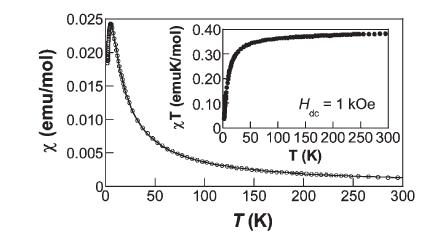 |
Superconducting Quantum Interference Devices or SQUIDs are used to measure the magnetic susceptibility of these compounds with respect to the sample temperature. Information about how they work can be found here or here. A great deal of information about the magnetic properties of the compound can be gained from these measurements.
 |
This can be seen from the peak on the plot as well as the positive slope of the inset plot in figure 1. A ferromagnetic compound would not have the peak present and would also have a negative slope on the xT plot. Additionally, one can fit the data above the peak using the Curie-Weiss law to plot 1/x vs T:

The width of the peak in Figure 1 can show the dimension of the magnetic interaction. The sharpness of the peak can be related to the magnetic dimension of the complex, simply put, the sharper the peak the higher the dimension.
Although it was not done for this particular compound, the ordering temperature can be determined by calculating the maximum of a plot of:

Various statistical mechanics models exist to characterize the behavior of these compounds. A few examples are listed below:
In this case a least squares fit of the data showed that the spin 1/2 Heisenberg Model best characterized the interactions. The fitting process also allows for an approximation of the strength of the interaction by calculating the exchange integral [2].